Can skiing solve its diversity problem?
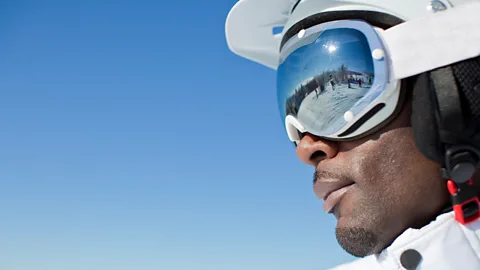 Getty Images
Getty ImagesPeople of colour have been historically excluded from the sport, but now, a series of Black-run organisations around the world are hoping to change that.
In early 2023, a coach full of skiers and snowboarders pulled into France's Chamonix resort at the base of Mont Blanc. After carving down the slopes by day, the group turned up to a blend of Afrobeats, R&B and dancehall music at night, roping resort guests into a tipsy rendition of the Electric Slide as the stars glimmered overhead. The trip had been organised by Soft Life Ski, a British collective which aims to bring "Afro-Caribbean culture and vibes to the slopes".
Despite being at one of the world's most famous mountain resorts, for five days, the group were the only Black skiers on the mountain. Today though, Soft Life Ski is one of a handful of organisations around the world working to address the sport's lack of diversity.
"If you go somewhere that is predominantly white [as a Black person], you might not feel at home," said Edmund Antwi, one of Soft Life Ski's co-founders. "We create room for those people to relax, enjoy their music, learn a new skill and have a laugh with people who look like them."
Skiing has always been an overwhelmingly white sport. According to an annual survey conducted by the National Ski Areas Association (NSAA), 88.1% of US skiers in the 2022-23 season were white, while just 1.5% were Black. In the UK, 2022 figures from Sport England show that white skiers made up nearly 70% of the total, while Black participation rates were too low to even register.
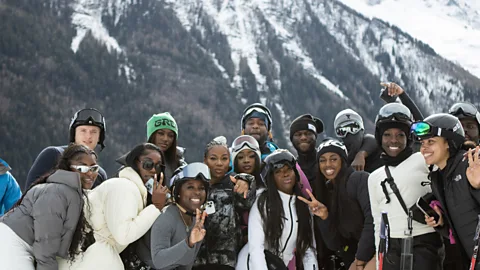 Soft Life Ski
Soft Life SkiBut how did skiing come to be so homogenous in the first place?
Skiing is widely believed to have been invented by Scandinavia's Indigenous Sami people and exported globally by emigrants from Europe's Alpine regions. These immigrants introduced skiing to the US in the late 19th Century, primarily as a means of transportation for those living in isolated mountain communities. Later, a wave of wealthy European migrants and US tourists, who frequented luxury resorts in Austria and Switzerland, spread its popularity and paved the way for a ski-based tourism industry in North America.
"The whiteness of skiing in the US is partly tied to [its] cultural, national and racial history," said Annie Gilbert Coleman, whose paper The Unbearable Whiteness of Skiing examines the sport's lack of diversity. "It's tied to the strategies of early resort owners, who were trying to bring investors in and make things look very sparkly. Celebrities and rich people were the target for [the popular Idaho ski resort] Sun Valley and they soon became the target for [Colorado's famous ski destination] Aspen, too."
Ski resorts started to open across the US in the 1910s and '20s. They often used stereotypical "all-American" images of cowboys astride their horses, ready to conquer the mountains. More prevalent, though, were symbols of "Europeanness" (think: Bavarian-style villages and German-language advertising slogans) used to market the Rocky Mountains as the Alps of the US.
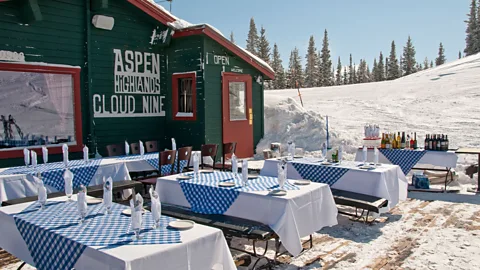 Alamy
Alamy"[There was] a very specific construction of white, elite ethnicity that harkened back to Austria, Germany, Norway and Sweden," said Gilbert Coleman. "Promoters merged them into this white ethnic image that became accessible to visitors through the purchase of European-made pants, boots and skis. When you went to a resort, you could eat at an Austrian restaurant, train with a French ski instructor and stay in a Swiss chalet." Inevitably, people of colour were excluded from this vision of mountain life – a fact that was exacerbated by segregationist policies in many of the early US ski clubs.
Want to join?
Soft Life Ski's upcoming trip to Hemsedal, Norway is sold out, but spaces are currently available for Mount Noire's upcoming trip to Val d'Isère, France, as well as Nubian Ski's upcoming trip to Japan and Dubai. The NBS also has details of dozens of local Black-run ski clubs across the US.
Today, many factors are used to explain low participation rates among non-white skiers – chiefly, its prohibitive cost. Skiing is expensive, but commentators have pointed out that many people of colour who could afford it actively choose not to. Generational factors may provide more insight. "It's something I call skiing pedigree," said Henri Rivers, president of the National Brotherhood of Snowsports (NBS), an umbrella organisation made up of 58 African American ski clubs across the US. "Growing up in this sport, I've seen so many families that have four or five generations of skiing. They have a house on the mountain, the whole family comes up every weekend, it's their lifestyle. That is something that we don't have historically as people of colour."
Yet, Black-run ski clubs actually have a long history. The oldest in the US, Jim Dandy, was established in Detroit, Michigan in 1958, and the NBS recently celebrated its 50th anniversary. In the UK, Nubian Ski was launched in 2000 and has organised 22 trips to resorts around the world. Now, a new wave of collectives focusing on increasing participation among young people of colour is following in their footsteps.
Soft Life Ski is one of them. The idea came about after a group of friends went skiing for the first time in Valfréjus, France. They had the time of their lives but were struck by the lack of diversity on and off the slopes. "Looking at these brands, looking at these resorts and not seeing yourself is something that subconsciously affects the mind. It makes you question if you're welcome," said Antwi.
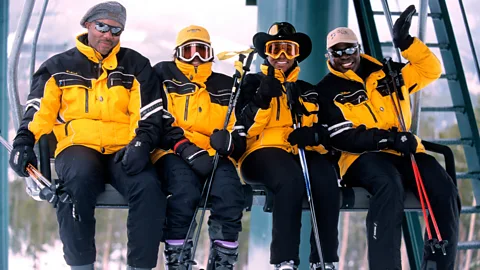 Alamy
AlamySimilarly, the British group Mount Noire, whose mission is "bringing colour to the mountain", was founded after a group of Black British university students visited a Slovakian resort. Launched in 2019, Mount Noire hosts regular ski trips with the aim of increasing Black participation in the sport. They went to Bansko, Bulgaria, earlier this year and are heading to Val d'Isère, France, in March.
According to the group's co-founder, Wenona Barnieh, the sheer whiteness of skiing is directly related to its marketing. "If I ever went on ski apparel websites, the outfits were always modelled by Caucasian people. It was very hard to find clothing that would actually fit me," she said. But the industry is now starting to take notice. Mount Noire has produced sponsored content for a long list of ski wear brands, including Ellesse and Oneskee. Likewise, Soft Life Ski has partnered with the Black-owned ski wear provider, Blanqo. And both Antwi and Barnieh have noticed an increase of diverse models in ski marketing.
In addition to brand partnerships, many Black-run skiing organisations are hoping to shake up the après-ski scene, too. "We listen to all music, we're versatile, but typically Black cultural music – R&B, hip-hop. [Elsewhere, you don't often] hear that on the mountains," said Barnieh.
Emmanuel Ojo, one of Soft Life Ski's co-founders, echoes her thoughts. "Most bars [at ski resorts] have the same resident DJ every Friday night and they're focused on EDM or electronic music. There's no opportunity for a different kind of night out. We want to change up those experiences and bring a bit of Afro-Caribbean culture into the mix," he said.
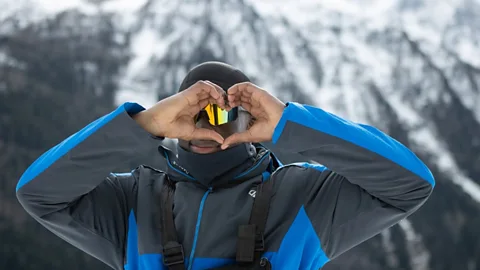 Soft Life Ski
Soft Life SkiWhen planning their trips, Mount Noire works with local bars to expand their musical repertoire, while other Black-run organisations sometimes invite artists on their trips. Ne-Yo and Anthony Hamilton performed at the 2023 NBS summit, and Soft Life Ski is flying a selection of Black British DJs to Norway for its upcoming trip to the Fyri Resort in Hemsedal in March. Ultimately, these efforts create a "home away from home" for new demographics, said Ojo. These collective experiences also help reduce self-consciousness for Black skiers. As Ojo said, "I'd rather stick out in a group of 20, then stick out in a group of two."
Since 2020, sporting bodies in the US and UK have implemented a series of measures to boost diversity in skiing. In 2021, US Ski & Snowboard entered a four-year partnership with the NBS, with the eventual aim of "elevating an African American to a World Cup podium". Snowsport England, the country's national governing body for snowsport, is currently working with Mount Noire to fund training for a Black ski instructor. And GB Snowsport is currently rolling out a three-year Diversity and Inclusion Action Plan, which aims to increase diversity among recreational skiers, instructors, coaches and, eventually, elite athletes.
"Our biggest focus is on taking a long-term view of diversity in snowsport," said GB Snowsport's chief executive, Vicky Gosling. "We're excited to support the current generation of athletes that are already in or are on the verge of breaking into the elite environment [...] In athletes like Siddhartha Ullah, Zoe Atkin and Nina Sparks, we've got great examples of young skiers and snowboarders from non-White backgrounds thriving within the British team setup, and that's something we're working to build on."
Resorts are joining the conversation, too. In 2021, the CEO of Vail Resorts published an open letter, writing: "We need to acknowledge that there are parts of the culture of our sport that are clearly not inviting. Maybe the image we have created of the mountain lifestyle needs to be more varied." And to mark Martin Luther King Jr Day – one of the most lucrative weekends for ski resorts in the US – Steamboat Ski Resort in Colorado raised $50,000 for the NBS. These efforts, combined with the work of groups like Soft Life Ski, Mount Noire and the NBS, mean that mountains are likely to become less snow-white in the decades to come.
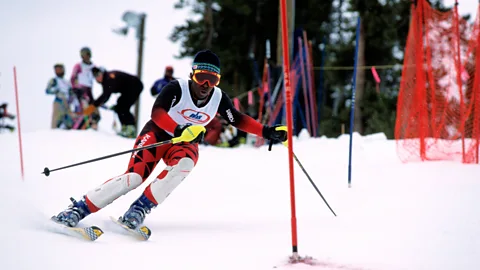 Alamy
AlamyUltimately, Rivers wants as many people as possible to reap the benefits of skiing. "Being outdoors, in the mountains, is spiritually invigorating. That's something every person on the planet should be able to do, no matter what colour they are."
---
If you liked this story, sign up for The Essential List newsletter – a handpicked selection of features, videos and can't-miss news delivered to your inbox every Friday.
